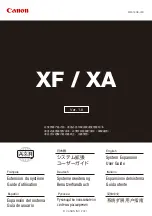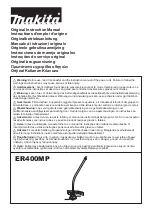
1. Connect the capacitive type ignition secondary probe to the CH A input terminal.
2. Connect the Inductive Pickup to the COM/TRIGGER input terminals and connect the COM input of the test tool to
vehicle ground by using a Ground Lead (black) in order to avoid electrical shock before clamping the capacitive
secondary pickup and the inductive pickup on the ignition wires.
NOTE
The Induct ive Pickup must be used to synchronize triggering bet ween the spark
plug wire signal and the coil secondary signal clamped by the capacitive secondary
probe.
3. Clip the secondary probe to the coil secondary lead wire and clamp the pickup probe on the spark plug wire close
to the spark plug.
IMPORTANT : Signals from individual spark plug wires are useful only for triggering. Ignition Peak Voltage, Burn
Voltage, and Burn Time measurements may not be accurate, if the signal is taken on the spark
plug side of the distributor, due to the rotor spark gap. For accurate measurements, use the coil
secondary signal before the distributor.
NOTE
I f you want to test S ECONDA RY IG NI TION SI NGLE , press t o highlight
SINGLE and SECONDARY IGNITION PARADE, press to highlight PARADE.
4. With the Key On, Engine Running (KOER), use the throttle to accelerate and decelerate the engine or drive the
vehicle as needed to make the driveability problem or misfire occur.
5. Make sure that the amplitude, frequency, shape and pulse width are all consistent from cylinder to cylinder. Look
for abnormalities in the section of the waveform that corresponds to specific components.
• Reference Waveform
VEHICLE INFORMATIONS
YEAR
: 1984
MAKE
: Mercedes-Benz
MODEL
: 380 SE
ENGINE
: 3.8 L
FUELSYS : CIS Fuel Injection
PCM_PIN : CH A to the Coil wire
STATUS
: KOER (Key On Running)
RPM
: Idle
ENG_TMP : Operating Temperature
VACUUM : 19.5 In. Hg
MILEAGE : 18575
6-63
Look closely to see that the pulse width (dwell) changes when engine load and RPM
changes.
FIRE = 9.20 kV
BURN = 7.42 V
DUR =2.39 ms
OF CYL 1
arc-over or
ignition voltage
spark or burn
voltage
ign. coil begins
charging here
Burn line
• Symptoms
No or hard starts, stalls, misfires, hesitation, poor fuel economy
• Test Procedure
NOTE
A Capacitive type ignition secondary probe must be used t o t est the ignition
secondary circuit.
Connecting the CH A or CH B leads directly to an ignition secondary circuit can
cause severe damage to the instrument or even personal injury.
Connect the test leads as displayed by the test tool’s HELP (Test Procedure) and shown in Figure below.
6-62
Firing lines should be equal. A short line
indicates low resistance in the wire. A high
line indicates high resistance in the wire
Firing lines clearly displayed
for easy comparison
Available voltage
should be about 10 kV
on a conventional ignition
system and even greater
with an electronic system
Spark lines can be viewed side-by-side
for ease of comparison
Cylinders are displayed in firing order












































